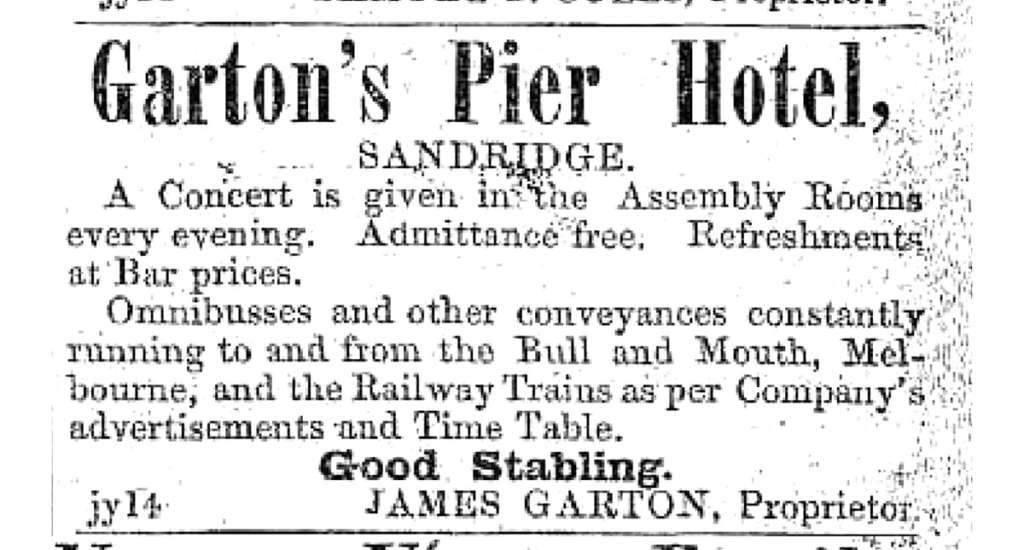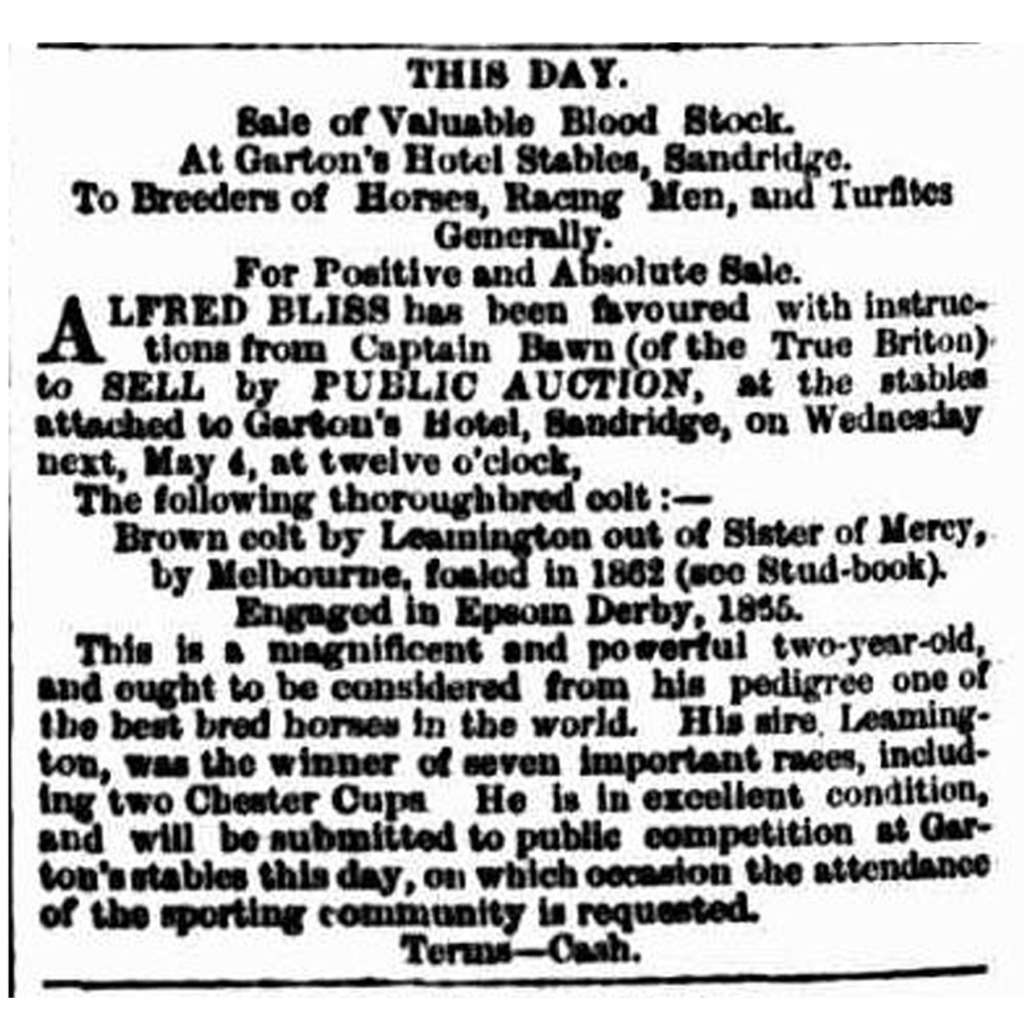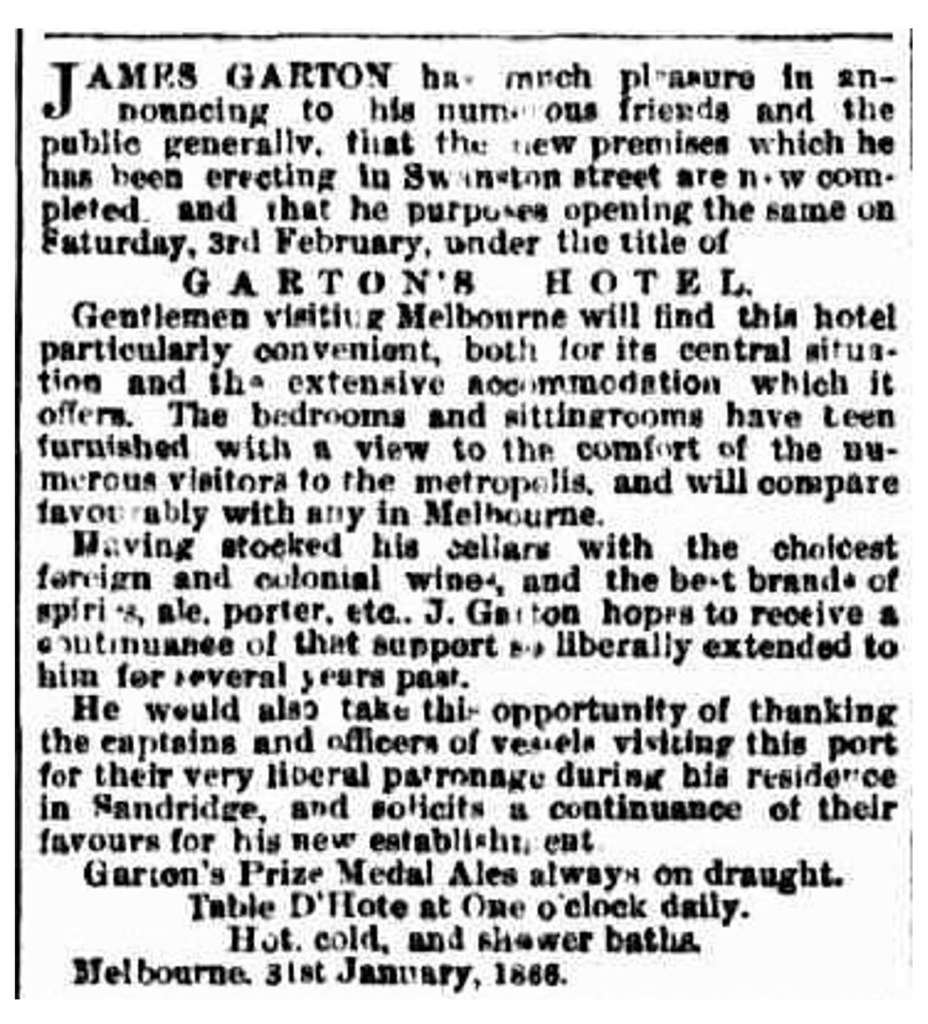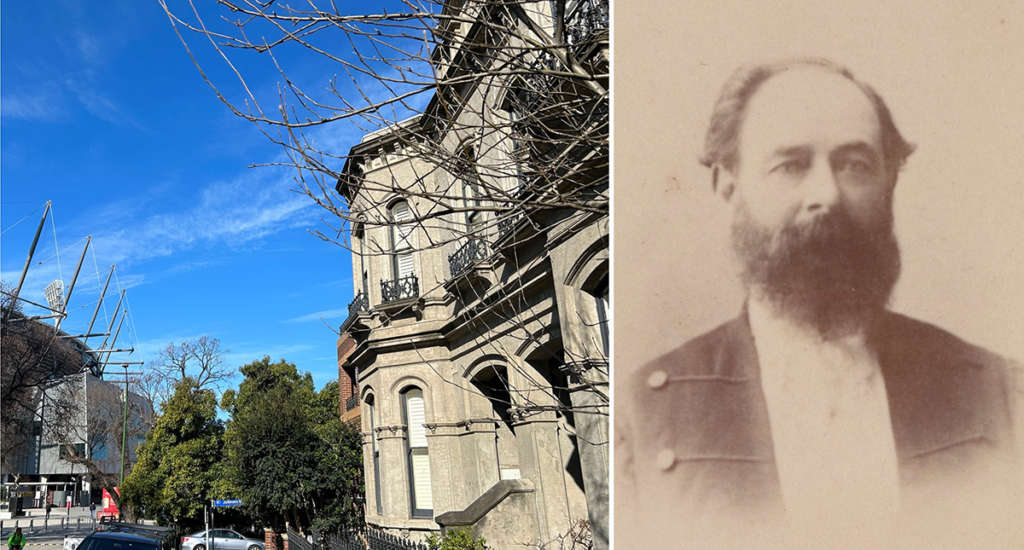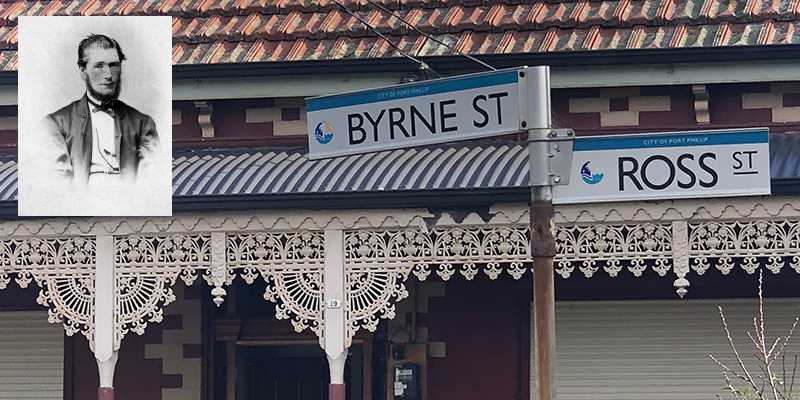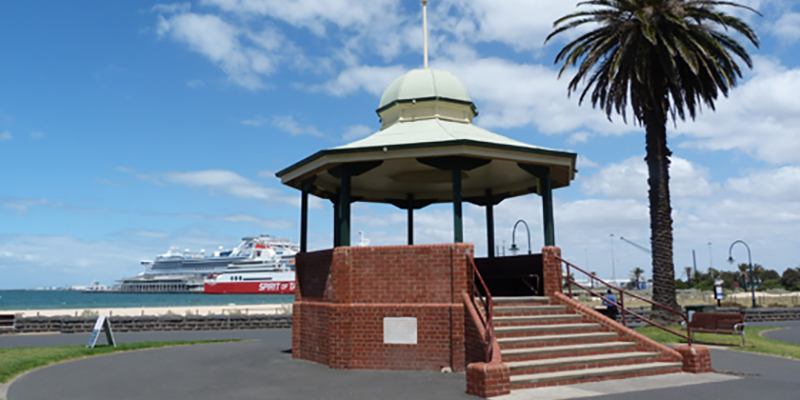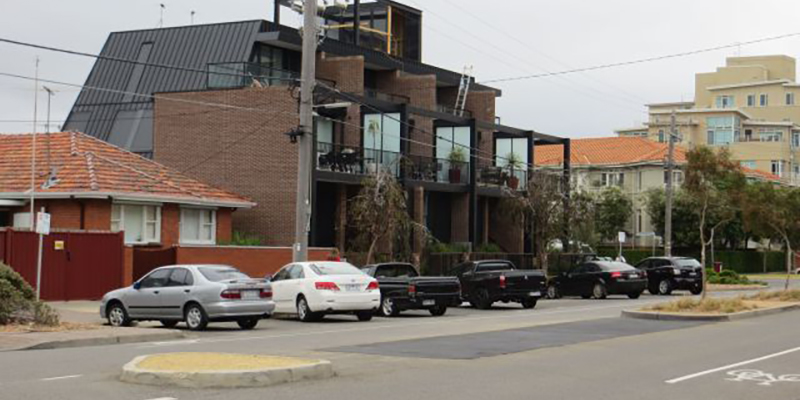James Garton: Hospitality and Horses
by David F Radcliffe
James Garton was granted the licence for the Pier Hotel in May 1853. Over the next decade or so, there wasn’t much that happened in Sandridge that did not involve him. Born in Bath, Somerset, he arrived in Melbourne aged 24 with his brother Richard in March 1850.[1] A brewer by trade, Garton is reported to have started out in Geelong before working with brewer Edward Norman in Flinders Lane. Having briefly operated the Woolpack Inn in the city, he moved to Sandridge at the height of the gold rush where he ran two of its iconic foreshore hotels. Garton was a genial, somewhat larger-than-life character, always up for a challenge. He was enterprising, engaging, and energetic.
When the Sandridge Sea Bath Association was formed in 1853, he was one of the directors.[2] In the wake of the massive fire that destroyed a large swath of Sandridge in January 1855, he was a member of a committee to raise funds to support the many victims.[3] Later that year, together with the likes of Ebeneezer Symes and Thomas Swallow, Garton helped raise funds to support Peter Lalor who had lost his arm at the Eureka Stockade. While acknowledging that many might disapprove of some of his tactics, these “Friends of Peter Lalor” felt that most of the community respected Lalor for his honesty and courage in “resisting the tyrannical and unconstitutional enforcement of an oppressive law”.[4]
Garton hosted meetings of professional groups such as the Licensed Victuallers’ Association and the Master Shipwrights at what was popularly known as Garton’s Pier Hotel.[5] He provided entertainment to entice customers from the city, offering transport as well as taking advantage of the recently opened Melbourne to Hobsons Bay railway. Somewhat cheekily, he even placed advertisements in the Williamstown press (see above).[6] Around 1856, Garton upgraded the Pier Hotel from a wooden to a brick structure.[7]
A keen sportsman, James Garton is reputed to have swum from Sandridge to Williamstown. His lasting passion, however, was horses. He not only owned and bred racehorses but also rode them.[8] His most memorable outing as a jockey was winning the Turf Club Cup in 1857 on the famous ‘Alice Hawthorne’.[9] Garton also rode in steeplechase events and was one of the founding members of the Melbourne Hunt Club. He was one of the original members of the Victorian Racing Club, formed in 1864 through the merger of the Victorian Turf Club and the Victorian Jockey Club.
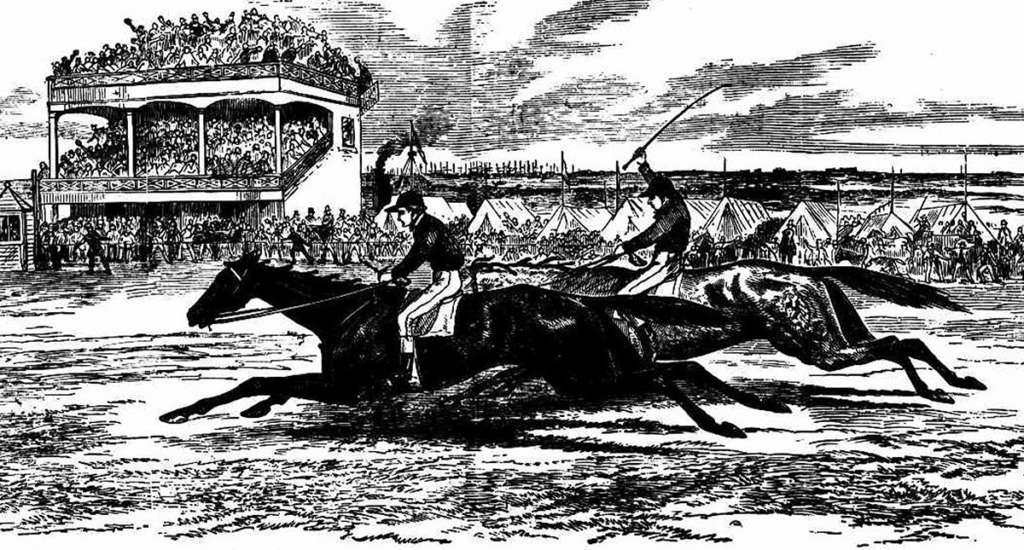
In February 1859, James Garton married Mary Ann Farquhar at St Paul’s Church, Melbourne.[11] She was the widow of New York and Melbourne-based merchant, Alexander Farquhar. The witnesses were James’ brother Richard and Andrew Plummer, a prominent citizen, and the local doctor in Sandridge. Mary Ann already had a young son James Farquhar and over the next five years, she and James had three children. Sadly, only one, Charles William Garton, survived infancy.[12]
Amidst these personal joys and sorrows, business continued. January 7, 1861, was a ‘red-letter day’ with thousands flocking to Sandridge to witness the Hobsons Bay Regatta with Sir Henry Barkly, the Victorian Governor, due to officiate on-board the Lightning.[13] Garton catered the event, providing refreshments for the 400~500 guests on the ship, Melbourne’s movers and shakers. His catering was ‘efficient and liberal’ and although he made a loss on the day, the result would have helped Garton further his reputation.[14] By August that year, Garton had moved to the London Hotel on Beach Street conveniently located next to the Sandridge railway station. In December, he erected a triumphal arch outside to greet the All England Eleven cricket team when they arrived at Railway Pier.[15]
But disaster struck in November 1862, when a fire destroyed many premises along Beach Street including the London. Garton was not adequately insured.[16] The rebuilt hotel was the grandest in Sandridge with 28 rooms welcoming new arrivals. Sometimes referred to as the Terminus, it was listed as Garton’s Family Hotel in 1864 when James travelled to England and the licencing board allowed Mary Ann to operate the hotel in his absence.[17] Garton was farewelled at a supper hosted by the Lord Mayor of Melbourne.[18] The stables at the hotel were sometimes used for bloodstock auctions.[19]
When the prospectus for the Union Gas Company was issued in March 1865, Garton was listed as one of the provisional directors.[20] Their goal was to supply gas at a price significantly lower than that of the City of Melbourne Gas and Coke Company, which had an effective monopoly. Although the Union Gas Company never raised sufficient capital, it paved the way for the South Melbourne Gas Company, a joint venture between the communities of Sandridge and Emerald Hill, which, a few years later, challenged this gas monopoly.
But the locus of his business and civic interests was gravitating towards the city. In February 1866, he opened Garton’s Hotel on Swanson Street, just up from the Melbourne Town Hall. Announcing the move, Garton encouraged his existing maritime patrons at Sandridge to remain loyal. The advertisement below lists the many delights of Garton’s new premises.[21]
In the late 1860s, his business interests diversified into operating livery and letting stables. The first was located between Bourke Street and Little Collins behind the Hunt Club, around the corner from his Swanston Street hotel. When the ‘great fire’ in Bourke Street erupted in July 1870, Garton rushed to save horses in his stable but many perished.[22] Later he opened Garton’s Horse and Carriage Repository, (aka Garton’s Horse Bazaar) on Lonsdale Street, opposite Melbourne Hospital.
For thirty years, James Garton contributed to the civic life of Melbourne in numerous ways. Having represented the Macarthur Ward (Sandridge) in 1859, he was subsequently elected to the Latrobe Ward and then the Gipps Ward of the Melbourne Council. Garton was appointed as a magistrate in 1877.[23] He served on the management committee of Melbourne Hospital and the Sailors Home, was treasurer for the Benevolent Asylum in North Melbourne and was a member of the Tramways Trust.[24]
Combining his organisational abilities with his love of sport, Garton was elected as the president of the Victorian Football Association (VFA) in 1882, succeeding Sir William Clarke, the inaugural president. His links with the VFA went back to at least 1879 when he was involved in arrangements for one of the earliest intercolonial football matches, Victoria versus South Australia.[25] During Garton’s tenure as president, many familiar facets of the game came into being. These included charging admission for spectators, independent and paid umpires, four quarters rather than two halves, and whistles for umpires. Also, while he was president, Port Melbourne joined the VFA.[26] In 1887, Garton stood down due to ill health.
Having lived on the premises of his hotels for much of his life, as Garton approached his fifties he built a substantial house, Fairmont on Albert Street, East Melbourne, in 1874. Eight years later he built Coningsby on Jolimont Terrace near the MCG. Both houses contained a pair of dwellings, one as a home for the Garton family and the other to rent.
Mary Ann Garton passed away in 1895, and James in 1900, aged 74. Their sons, James and Charles, continued the horse and coach business, which later became Garton’s Motor Garage, a taxi and vehicle hire service as automobiles began to replace horses for transport.[27] Garton Street, Sandridge was named for James Garton in 1860 when he was in his prime there. It seems Garton Street, Princes Hill was also named for him as he reached his zenith in Melbourne.
For more on James Garton, the article published in Table Talk in 1892, in the lead-up to the jubilee of the City of Melbourne, paints a colourful picture of this much-admired citizen of Sandridge and Melbourne.
[1] Richard Garton settled in Hamilton, where he raised a family and served the community in all manner of civic roles. 1901 ‘DEATH OF MR. R. GARTON.’, Hamilton Spectator (Vic.: 1870 – 1918), 30 July, p. 2., viewed 16 Aug 2023, http://nla.gov.au/nla.news-article226091108
[2] 1853 ‘Advertising’, The Banner (Melbourne, Vic.: 1853 – 1854), 27 December, p. 11., viewed 14 Aug 2023, http://nla.gov.au/nla.news-article179482282
[3] Nancy U’Ren and Noel Turnbull, A History of Port Melbourne, Oxford University Press, 1983, p. 53.
[4] 1855 ‘Advertising’, The Age (Melbourne, Vic.: 1854 – 1954), 7 July, p. 2., viewed 14 Aug 2023, http://nla.gov.au/nla.news-article154891661
[5] 1856 ‘Advertising’, The Argus (Melbourne, Vic.: 1848 – 1957), 22 August, p. 3., viewed 14 Aug 2023, http://nla.gov.au/nla.news-article7135281
[6] 1855 ‘Advertising’, Williamstown Trade Circular (Vic.: 1855 – 1856), 2 June, p. 4., viewed 15 Aug 2023, http://nla.gov.au/nla.news-article155833756
[7] Pat Grainger, Chartered Scoundrels: A Brief History of Port Melbourne, 2nd Ed, PMHPS, 2017, p. 73.
[8] 1854 ‘MELBOURNE RACES.’, The Argus (Melbourne, Vic.: 1848 – 1957), 23 March, p. 5., viewed 14 Aug 2023, http://nla.gov.au/nla.news-article4804784
[9] 1857 ‘THE RACES.’, The Age (Melbourne, Vic.: 1854 – 1954), 27 March, p. 5., viewed 14 Aug 2023, http://nla.gov.au/nla.news-article154822164
[10] 1891 ‘Flemington: Past and Present.’, Illustrated Sydney News (NSW : 1881 – 1894), 24 October, p. 13. , viewed 04 Sep 2023, http://nla.gov.au/nla.news-article63613318
[11] 1859 ‘Family Notices’, The Argus (Melbourne, Vic.: 1848 – 1957), 26 February, p. 4. , viewed 15 Aug 2023, http://nla.gov.au/nla.news-article5677034 St Paul’s Church was replaced in 1891 with the cathedral we know today.
[12] Although James Farquhar was born in December 1854, he was not baptised until August 1860. This took place in Holy Trinity Church, Sandridge the same day Richard Reynolds Garton, born May 1860, was baptised. Richard died two years later.
[13] Interestingly Barkly Avenue in Port Melbourne runs off Garton Street.
[14] 1861 ‘HOBSON’S BAY REGATTA.’, The Argus (Melbourne, Vic.: 1848 – 1957), 7 January, p. 5., viewed 15 Aug 2023, http://nla.gov.au/nla.news-article5696463 Governor Barkly was a late withdrawal from the event.
[15] 1861 ‘THE NEWS OF THE DAY.’, The Age (Melbourne, Vic.: 1854 – 1954), 24 December, p. 5., viewed 15 Aug 2023, http://nla.gov.au/nla.news-article154845112
[16] 1862 ‘GREAT CONFLAGRATION AT SANDRIDGE.’, The Herald (Melbourne, Vic.: 1861 – 1954), 14 November, p. 5., viewed 15 Aug 2023, http://nla.gov.au/nla.news-article244405451 This story incorrectly names Garton’s hotel as the Pier rather than the London.
[17] 1864 ‘WEDNESDAY, MARCH 2, 1864.’, The Argus (Melbourne, Vic.: 1848 – 1957), 2 March, p. 4, viewed 15 Aug 2023, http://nla.gov.au/nla.news-article5745057
[18] 1864 ‘NEWS OF THE WEEK.’, The Farmer’s Journal and Gardener’s Chronicle (Melbourne, Vic.: 1862 – 1864), 26 February, p. 3., viewed 15 Aug 2023, http://nla.gov.au/nla.news-article179479493
[19] 1864 ‘Advertising’, The Argus (Melbourne, Vic.: 1848 – 1957), 4 May, p. 2., viewed 22 Aug 2023, http://nla.gov.au/nla.news-article5748493
[20] 1865 ‘Advertising’, The Herald (Melbourne, Vic.: 1861 – 1954), 11 March, p. 4., viewed 15 Aug 2023, http://nla.gov.au/nla.news-article245508012
[21] 1866 ‘Advertising’, The Herald (Melbourne, Vic.: 1861 – 1954), 9 February, p. 1., viewed 16 Aug 2023, http://nla.gov.au/nla.news-article244470759
[22] 1870 ‘THE GREAT FIRE IN BOURKE-STREET.’, The Argus (Melbourne, Vic.: 1848 – 1957), 6 July, p. 7., viewed 18 Aug 2023, http://nla.gov.au/nla.news-article5824870
[23] Victorian Government Gazette, No. 57, 15 May 1877, p. 923.
[24] 1900 ‘ABOUT PEOPLE.’, The Age (Melbourne, Vic.: 1854 – 1954), 16 October, p. 4., viewed 21 Aug 2023, http://nla.gov.au/nla.news-article188650717
[25] 1879 ‘Football’, Adelaide Observer (SA: 1843 – 1904), 5 July, p. 5., viewed 16 Aug 2023, http://nla.gov.au/nla.news-article160122272
[26] Marc Fiddian, The VFA: a history of the Victorian Football Association, 1877–1995, Melbourne Sports Books, 2004, p. 21.
[27] 1910 ‘Advertising’, The Herald (Melbourne, Vic.: 1861 – 1954), 10 March, p. 2., viewed 21 Aug 2023, http://nla.gov.au/nla.news-article242090962. In one of those quirks of history, the land on Lonsdale Street once occupied by Garton’s Horse and Coach Repository and later Garton’s Motor Garage still stores vehicles today as the Golden Square Parking Garage.

